Financial Analysis and Variance Report
VerifiedAdded on 2020/07/22
|14
|3793
|71
AI Summary
The provided document is a detailed report on various types of financial analysis and variance reports. It covers fixed and actual budgets, management reports, financial statements, break-even analysis, profits calculation, and rate of return (ARR) and internal rate of return (IRR). The report also discusses the credibility of investment plans with regard to profitability and specific rate of return. References are provided from books and journals, including Oxford University Press and National Bureau of Economic Research.
Contribute Materials
Your contribution can guide someone’s learning journey. Share your
documents today.
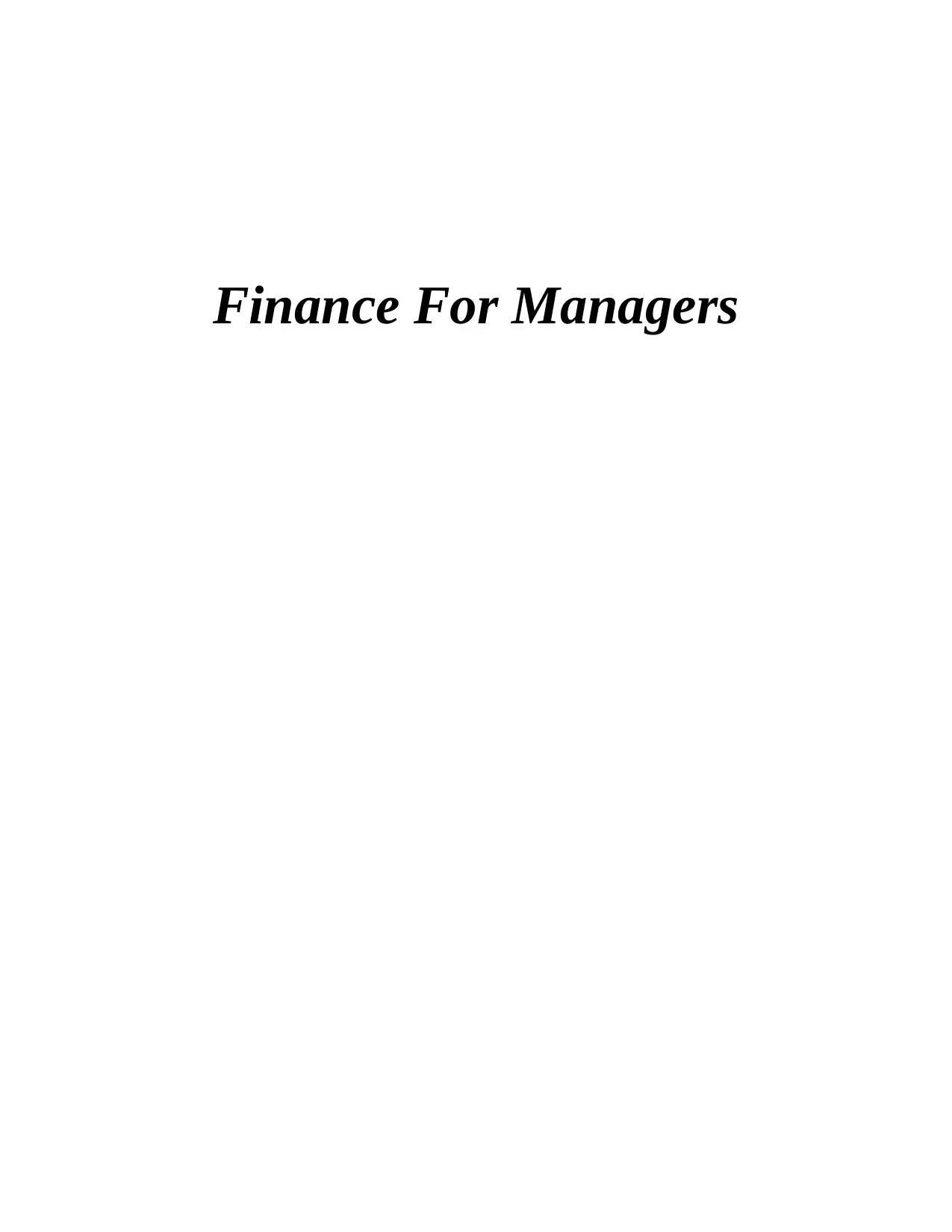
Finance For Managers
Secure Best Marks with AI Grader
Need help grading? Try our AI Grader for instant feedback on your assignments.
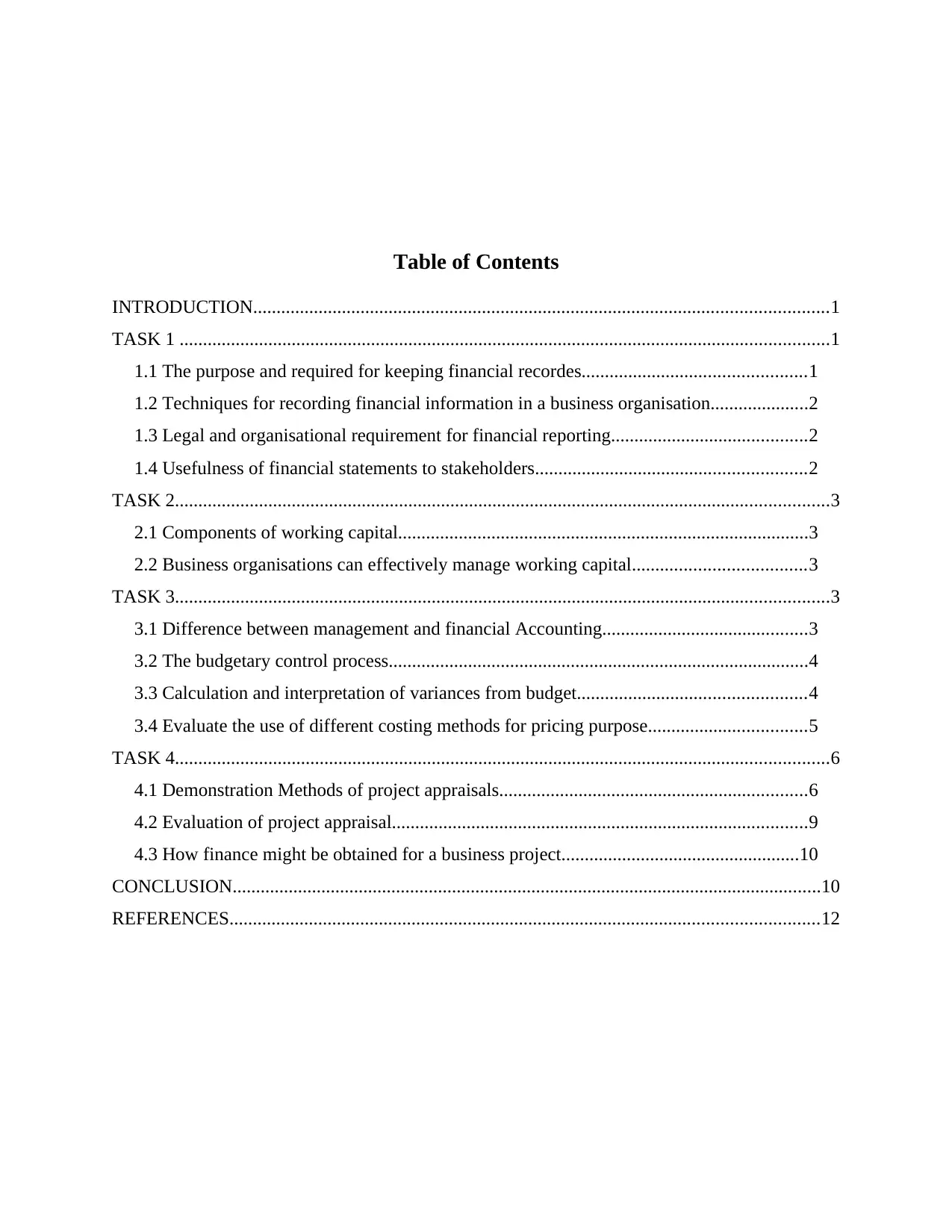
Table of Contents
INTRODUCTION...........................................................................................................................1
TASK 1 ...........................................................................................................................................1
1.1 The purpose and required for keeping financial recordes................................................1
1.2 Techniques for recording financial information in a business organisation.....................2
1.3 Legal and organisational requirement for financial reporting..........................................2
1.4 Usefulness of financial statements to stakeholders..........................................................2
TASK 2............................................................................................................................................3
2.1 Components of working capital........................................................................................3
2.2 Business organisations can effectively manage working capital.....................................3
TASK 3............................................................................................................................................3
3.1 Difference between management and financial Accounting............................................3
3.2 The budgetary control process..........................................................................................4
3.3 Calculation and interpretation of variances from budget.................................................4
3.4 Evaluate the use of different costing methods for pricing purpose..................................5
TASK 4............................................................................................................................................6
4.1 Demonstration Methods of project appraisals..................................................................6
4.2 Evaluation of project appraisal.........................................................................................9
4.3 How finance might be obtained for a business project...................................................10
CONCLUSION..............................................................................................................................10
REFERENCES..............................................................................................................................12
INTRODUCTION...........................................................................................................................1
TASK 1 ...........................................................................................................................................1
1.1 The purpose and required for keeping financial recordes................................................1
1.2 Techniques for recording financial information in a business organisation.....................2
1.3 Legal and organisational requirement for financial reporting..........................................2
1.4 Usefulness of financial statements to stakeholders..........................................................2
TASK 2............................................................................................................................................3
2.1 Components of working capital........................................................................................3
2.2 Business organisations can effectively manage working capital.....................................3
TASK 3............................................................................................................................................3
3.1 Difference between management and financial Accounting............................................3
3.2 The budgetary control process..........................................................................................4
3.3 Calculation and interpretation of variances from budget.................................................4
3.4 Evaluate the use of different costing methods for pricing purpose..................................5
TASK 4............................................................................................................................................6
4.1 Demonstration Methods of project appraisals..................................................................6
4.2 Evaluation of project appraisal.........................................................................................9
4.3 How finance might be obtained for a business project...................................................10
CONCLUSION..............................................................................................................................10
REFERENCES..............................................................................................................................12
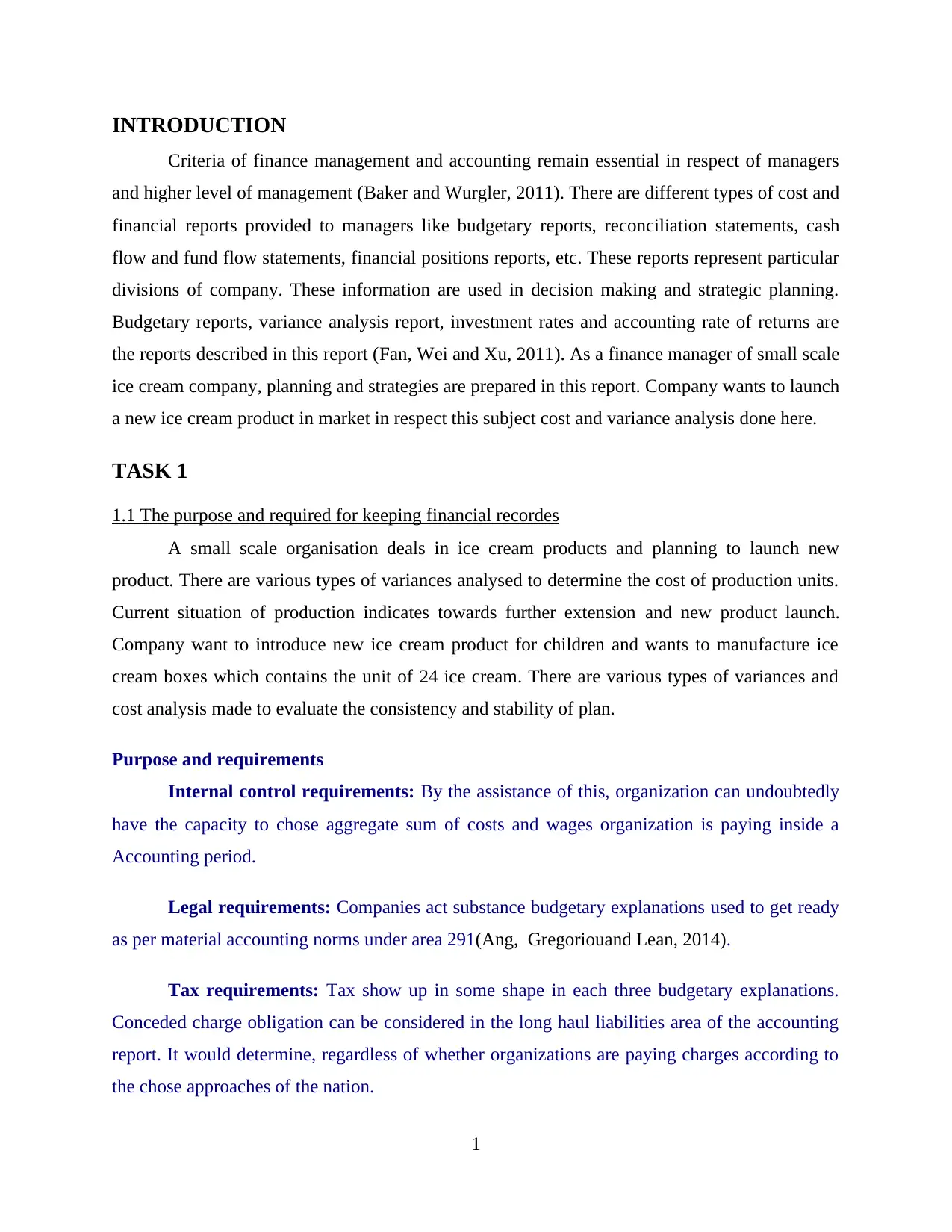
INTRODUCTION
Criteria of finance management and accounting remain essential in respect of managers
and higher level of management (Baker and Wurgler, 2011). There are different types of cost and
financial reports provided to managers like budgetary reports, reconciliation statements, cash
flow and fund flow statements, financial positions reports, etc. These reports represent particular
divisions of company. These information are used in decision making and strategic planning.
Budgetary reports, variance analysis report, investment rates and accounting rate of returns are
the reports described in this report (Fan, Wei and Xu, 2011). As a finance manager of small scale
ice cream company, planning and strategies are prepared in this report. Company wants to launch
a new ice cream product in market in respect this subject cost and variance analysis done here.
TASK 1
1.1 The purpose and required for keeping financial recordes
A small scale organisation deals in ice cream products and planning to launch new
product. There are various types of variances analysed to determine the cost of production units.
Current situation of production indicates towards further extension and new product launch.
Company want to introduce new ice cream product for children and wants to manufacture ice
cream boxes which contains the unit of 24 ice cream. There are various types of variances and
cost analysis made to evaluate the consistency and stability of plan.
Purpose and requirements
Internal control requirements: By the assistance of this, organization can undoubtedly
have the capacity to chose aggregate sum of costs and wages organization is paying inside a
Accounting period.
Legal requirements: Companies act substance budgetary explanations used to get ready
as per material accounting norms under area 291(Ang, Gregoriouand Lean, 2014).
Tax requirements: Tax show up in some shape in each three budgetary explanations.
Conceded charge obligation can be considered in the long haul liabilities area of the accounting
report. It would determine, regardless of whether organizations are paying charges according to
the chose approaches of the nation.
1
Criteria of finance management and accounting remain essential in respect of managers
and higher level of management (Baker and Wurgler, 2011). There are different types of cost and
financial reports provided to managers like budgetary reports, reconciliation statements, cash
flow and fund flow statements, financial positions reports, etc. These reports represent particular
divisions of company. These information are used in decision making and strategic planning.
Budgetary reports, variance analysis report, investment rates and accounting rate of returns are
the reports described in this report (Fan, Wei and Xu, 2011). As a finance manager of small scale
ice cream company, planning and strategies are prepared in this report. Company wants to launch
a new ice cream product in market in respect this subject cost and variance analysis done here.
TASK 1
1.1 The purpose and required for keeping financial recordes
A small scale organisation deals in ice cream products and planning to launch new
product. There are various types of variances analysed to determine the cost of production units.
Current situation of production indicates towards further extension and new product launch.
Company want to introduce new ice cream product for children and wants to manufacture ice
cream boxes which contains the unit of 24 ice cream. There are various types of variances and
cost analysis made to evaluate the consistency and stability of plan.
Purpose and requirements
Internal control requirements: By the assistance of this, organization can undoubtedly
have the capacity to chose aggregate sum of costs and wages organization is paying inside a
Accounting period.
Legal requirements: Companies act substance budgetary explanations used to get ready
as per material accounting norms under area 291(Ang, Gregoriouand Lean, 2014).
Tax requirements: Tax show up in some shape in each three budgetary explanations.
Conceded charge obligation can be considered in the long haul liabilities area of the accounting
report. It would determine, regardless of whether organizations are paying charges according to
the chose approaches of the nation.
1
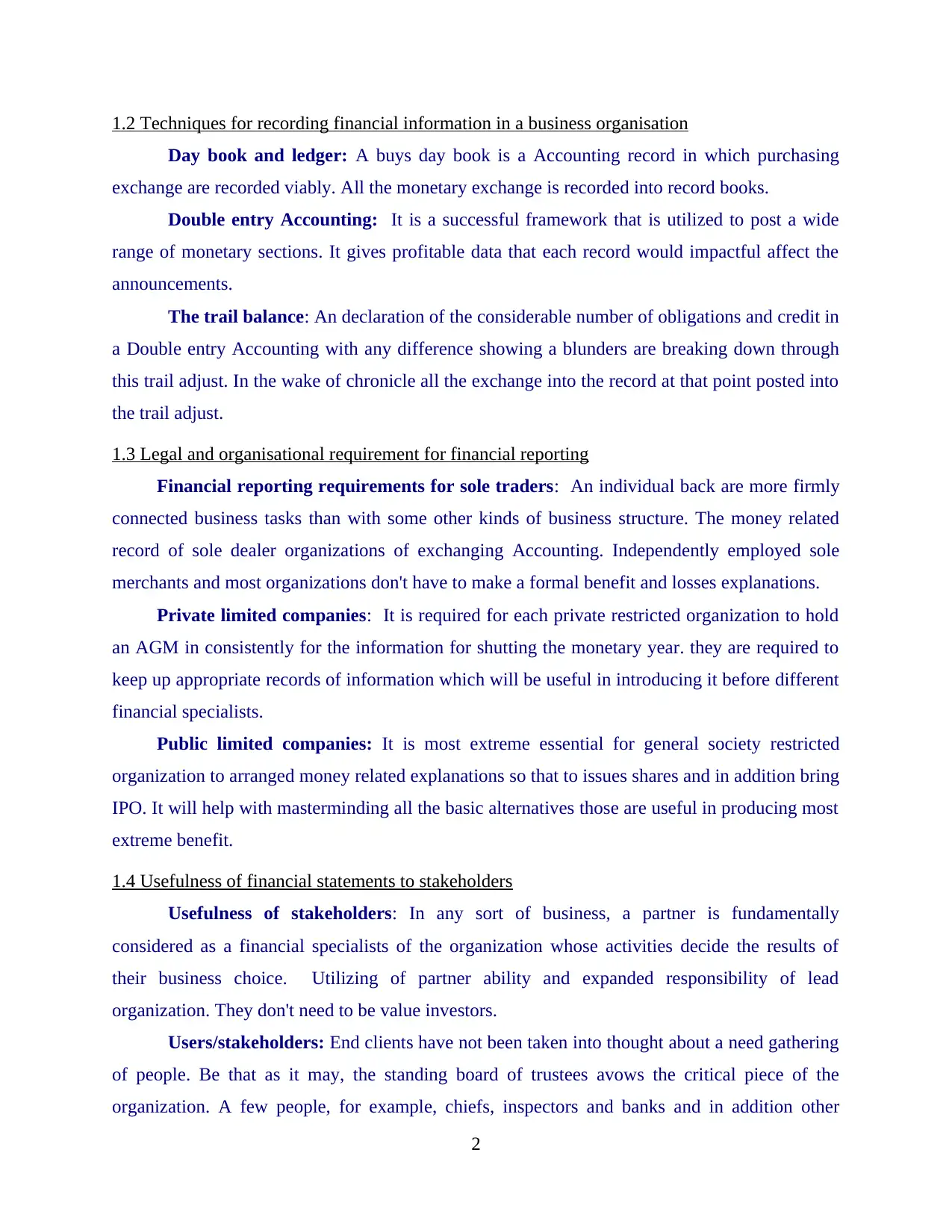
1.2 Techniques for recording financial information in a business organisation
Day book and ledger: A buys day book is a Accounting record in which purchasing
exchange are recorded viably. All the monetary exchange is recorded into record books.
Double entry Accounting: It is a successful framework that is utilized to post a wide
range of monetary sections. It gives profitable data that each record would impactful affect the
announcements.
The trail balance: An declaration of the considerable number of obligations and credit in
a Double entry Accounting with any difference showing a blunders are breaking down through
this trail adjust. In the wake of chronicle all the exchange into the record at that point posted into
the trail adjust.
1.3 Legal and organisational requirement for financial reporting
Financial reporting requirements for sole traders: An individual back are more firmly
connected business tasks than with some other kinds of business structure. The money related
record of sole dealer organizations of exchanging Accounting. Independently employed sole
merchants and most organizations don't have to make a formal benefit and losses explanations.
Private limited companies: It is required for each private restricted organization to hold
an AGM in consistently for the information for shutting the monetary year. they are required to
keep up appropriate records of information which will be useful in introducing it before different
financial specialists.
Public limited companies: It is most extreme essential for general society restricted
organization to arranged money related explanations so that to issues shares and in addition bring
IPO. It will help with masterminding all the basic alternatives those are useful in producing most
extreme benefit.
1.4 Usefulness of financial statements to stakeholders
Usefulness of stakeholders: In any sort of business, a partner is fundamentally
considered as a financial specialists of the organization whose activities decide the results of
their business choice. Utilizing of partner ability and expanded responsibility of lead
organization. They don't need to be value investors.
Users/stakeholders: End clients have not been taken into thought about a need gathering
of people. Be that as it may, the standing board of trustees avows the critical piece of the
organization. A few people, for example, chiefs, inspectors and banks and in addition other
2
Day book and ledger: A buys day book is a Accounting record in which purchasing
exchange are recorded viably. All the monetary exchange is recorded into record books.
Double entry Accounting: It is a successful framework that is utilized to post a wide
range of monetary sections. It gives profitable data that each record would impactful affect the
announcements.
The trail balance: An declaration of the considerable number of obligations and credit in
a Double entry Accounting with any difference showing a blunders are breaking down through
this trail adjust. In the wake of chronicle all the exchange into the record at that point posted into
the trail adjust.
1.3 Legal and organisational requirement for financial reporting
Financial reporting requirements for sole traders: An individual back are more firmly
connected business tasks than with some other kinds of business structure. The money related
record of sole dealer organizations of exchanging Accounting. Independently employed sole
merchants and most organizations don't have to make a formal benefit and losses explanations.
Private limited companies: It is required for each private restricted organization to hold
an AGM in consistently for the information for shutting the monetary year. they are required to
keep up appropriate records of information which will be useful in introducing it before different
financial specialists.
Public limited companies: It is most extreme essential for general society restricted
organization to arranged money related explanations so that to issues shares and in addition bring
IPO. It will help with masterminding all the basic alternatives those are useful in producing most
extreme benefit.
1.4 Usefulness of financial statements to stakeholders
Usefulness of stakeholders: In any sort of business, a partner is fundamentally
considered as a financial specialists of the organization whose activities decide the results of
their business choice. Utilizing of partner ability and expanded responsibility of lead
organization. They don't need to be value investors.
Users/stakeholders: End clients have not been taken into thought about a need gathering
of people. Be that as it may, the standing board of trustees avows the critical piece of the
organization. A few people, for example, chiefs, inspectors and banks and in addition other
2
Secure Best Marks with AI Grader
Need help grading? Try our AI Grader for instant feedback on your assignments.
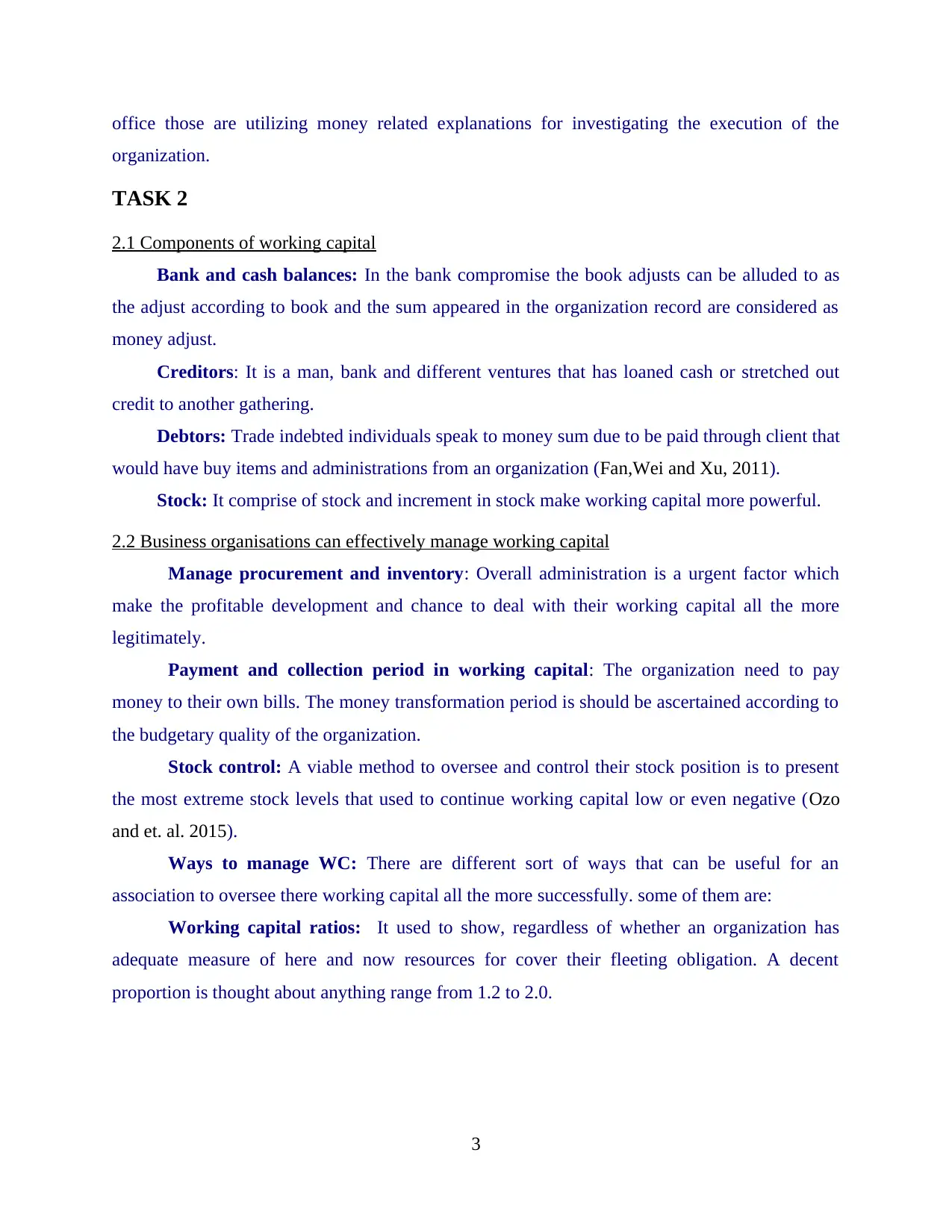
office those are utilizing money related explanations for investigating the execution of the
organization.
TASK 2
2.1 Components of working capital
Bank and cash balances: In the bank compromise the book adjusts can be alluded to as
the adjust according to book and the sum appeared in the organization record are considered as
money adjust.
Creditors: It is a man, bank and different ventures that has loaned cash or stretched out
credit to another gathering.
Debtors: Trade indebted individuals speak to money sum due to be paid through client that
would have buy items and administrations from an organization (Fan,Wei and Xu, 2011).
Stock: It comprise of stock and increment in stock make working capital more powerful.
2.2 Business organisations can effectively manage working capital
Manage procurement and inventory: Overall administration is a urgent factor which
make the profitable development and chance to deal with their working capital all the more
legitimately.
Payment and collection period in working capital: The organization need to pay
money to their own bills. The money transformation period is should be ascertained according to
the budgetary quality of the organization.
Stock control: A viable method to oversee and control their stock position is to present
the most extreme stock levels that used to continue working capital low or even negative (Ozo
and et. al. 2015).
Ways to manage WC: There are different sort of ways that can be useful for an
association to oversee there working capital all the more successfully. some of them are:
Working capital ratios: It used to show, regardless of whether an organization has
adequate measure of here and now resources for cover their fleeting obligation. A decent
proportion is thought about anything range from 1.2 to 2.0.
3
organization.
TASK 2
2.1 Components of working capital
Bank and cash balances: In the bank compromise the book adjusts can be alluded to as
the adjust according to book and the sum appeared in the organization record are considered as
money adjust.
Creditors: It is a man, bank and different ventures that has loaned cash or stretched out
credit to another gathering.
Debtors: Trade indebted individuals speak to money sum due to be paid through client that
would have buy items and administrations from an organization (Fan,Wei and Xu, 2011).
Stock: It comprise of stock and increment in stock make working capital more powerful.
2.2 Business organisations can effectively manage working capital
Manage procurement and inventory: Overall administration is a urgent factor which
make the profitable development and chance to deal with their working capital all the more
legitimately.
Payment and collection period in working capital: The organization need to pay
money to their own bills. The money transformation period is should be ascertained according to
the budgetary quality of the organization.
Stock control: A viable method to oversee and control their stock position is to present
the most extreme stock levels that used to continue working capital low or even negative (Ozo
and et. al. 2015).
Ways to manage WC: There are different sort of ways that can be useful for an
association to oversee there working capital all the more successfully. some of them are:
Working capital ratios: It used to show, regardless of whether an organization has
adequate measure of here and now resources for cover their fleeting obligation. A decent
proportion is thought about anything range from 1.2 to 2.0.
3
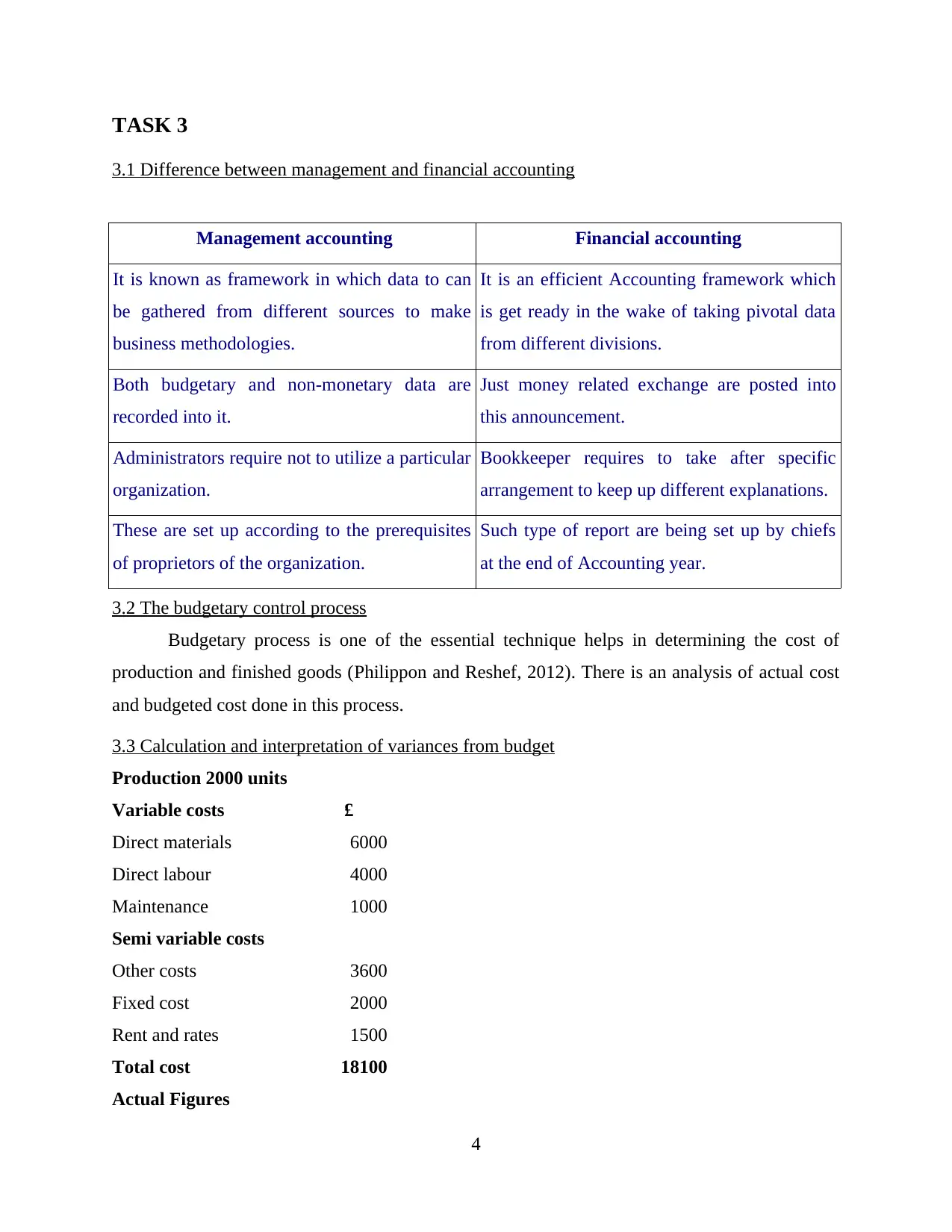
TASK 3
3.1 Difference between management and financial accounting
Management accounting Financial accounting
It is known as framework in which data to can
be gathered from different sources to make
business methodologies.
It is an efficient Accounting framework which
is get ready in the wake of taking pivotal data
from different divisions.
Both budgetary and non-monetary data are
recorded into it.
Just money related exchange are posted into
this announcement.
Administrators require not to utilize a particular
organization.
Bookkeeper requires to take after specific
arrangement to keep up different explanations.
These are set up according to the prerequisites
of proprietors of the organization.
Such type of report are being set up by chiefs
at the end of Accounting year.
3.2 The budgetary control process
Budgetary process is one of the essential technique helps in determining the cost of
production and finished goods (Philippon and Reshef, 2012). There is an analysis of actual cost
and budgeted cost done in this process.
3.3 Calculation and interpretation of variances from budget
Production 2000 units
Variable costs £
Direct materials 6000
Direct labour 4000
Maintenance 1000
Semi variable costs
Other costs 3600
Fixed cost 2000
Rent and rates 1500
Total cost 18100
Actual Figures
4
3.1 Difference between management and financial accounting
Management accounting Financial accounting
It is known as framework in which data to can
be gathered from different sources to make
business methodologies.
It is an efficient Accounting framework which
is get ready in the wake of taking pivotal data
from different divisions.
Both budgetary and non-monetary data are
recorded into it.
Just money related exchange are posted into
this announcement.
Administrators require not to utilize a particular
organization.
Bookkeeper requires to take after specific
arrangement to keep up different explanations.
These are set up according to the prerequisites
of proprietors of the organization.
Such type of report are being set up by chiefs
at the end of Accounting year.
3.2 The budgetary control process
Budgetary process is one of the essential technique helps in determining the cost of
production and finished goods (Philippon and Reshef, 2012). There is an analysis of actual cost
and budgeted cost done in this process.
3.3 Calculation and interpretation of variances from budget
Production 2000 units
Variable costs £
Direct materials 6000
Direct labour 4000
Maintenance 1000
Semi variable costs
Other costs 3600
Fixed cost 2000
Rent and rates 1500
Total cost 18100
Actual Figures
4
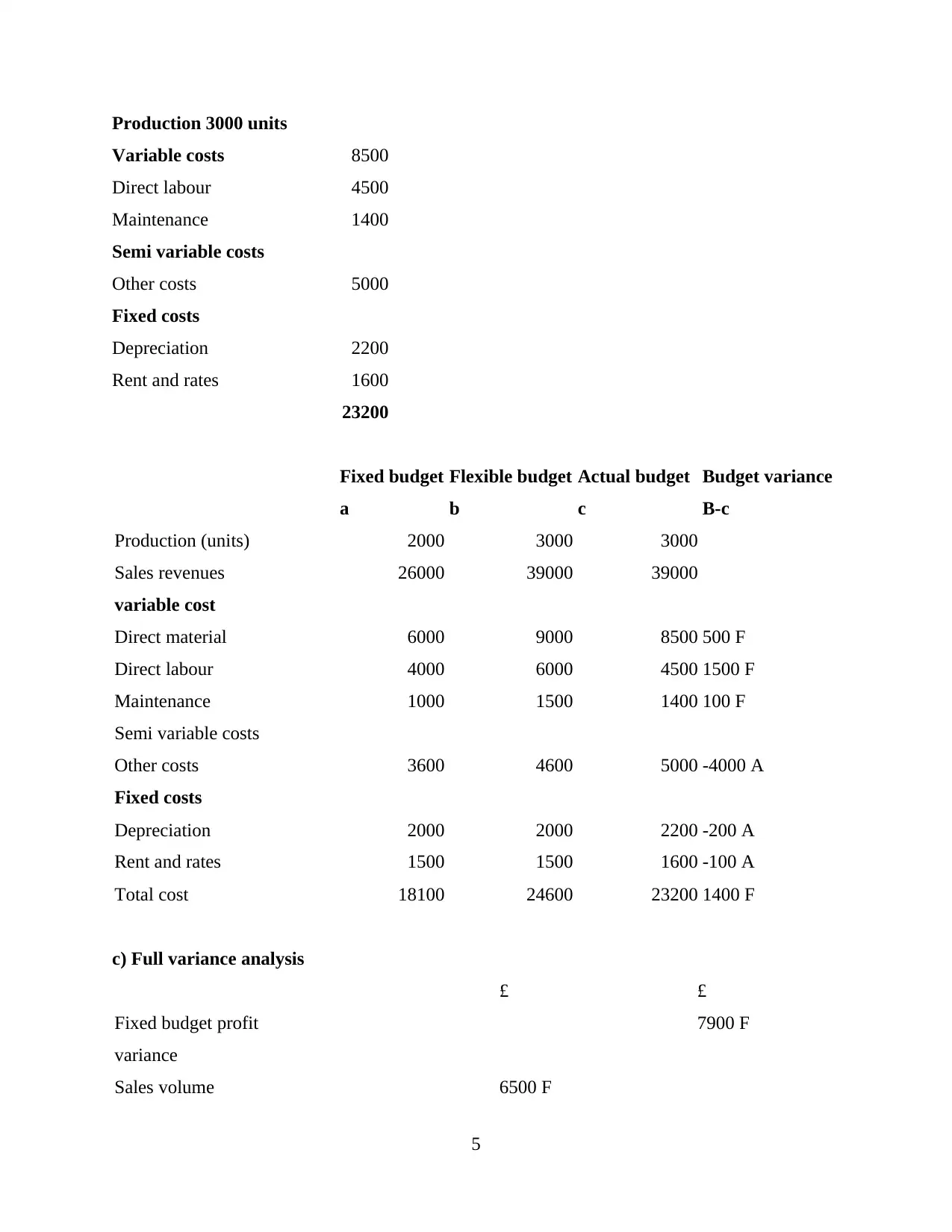
Production 3000 units
Variable costs 8500
Direct labour 4500
Maintenance 1400
Semi variable costs
Other costs 5000
Fixed costs
Depreciation 2200
Rent and rates 1600
23200
Fixed budget Flexible budget Actual budget Budget variance
a b c B-c
Production (units) 2000 3000 3000
Sales revenues 26000 39000 39000
variable cost
Direct material 6000 9000 8500 500 F
Direct labour 4000 6000 4500 1500 F
Maintenance 1000 1500 1400 100 F
Semi variable costs
Other costs 3600 4600 5000 -4000 A
Fixed costs
Depreciation 2000 2000 2200 -200 A
Rent and rates 1500 1500 1600 -100 A
Total cost 18100 24600 23200 1400 F
c) Full variance analysis
£ £
Fixed budget profit 7900 F
variance
Sales volume 6500 F
5
Variable costs 8500
Direct labour 4500
Maintenance 1400
Semi variable costs
Other costs 5000
Fixed costs
Depreciation 2200
Rent and rates 1600
23200
Fixed budget Flexible budget Actual budget Budget variance
a b c B-c
Production (units) 2000 3000 3000
Sales revenues 26000 39000 39000
variable cost
Direct material 6000 9000 8500 500 F
Direct labour 4000 6000 4500 1500 F
Maintenance 1000 1500 1400 100 F
Semi variable costs
Other costs 3600 4600 5000 -4000 A
Fixed costs
Depreciation 2000 2000 2200 -200 A
Rent and rates 1500 1500 1600 -100 A
Total cost 18100 24600 23200 1400 F
c) Full variance analysis
£ £
Fixed budget profit 7900 F
variance
Sales volume 6500 F
5
Paraphrase This Document
Need a fresh take? Get an instant paraphrase of this document with our AI Paraphraser
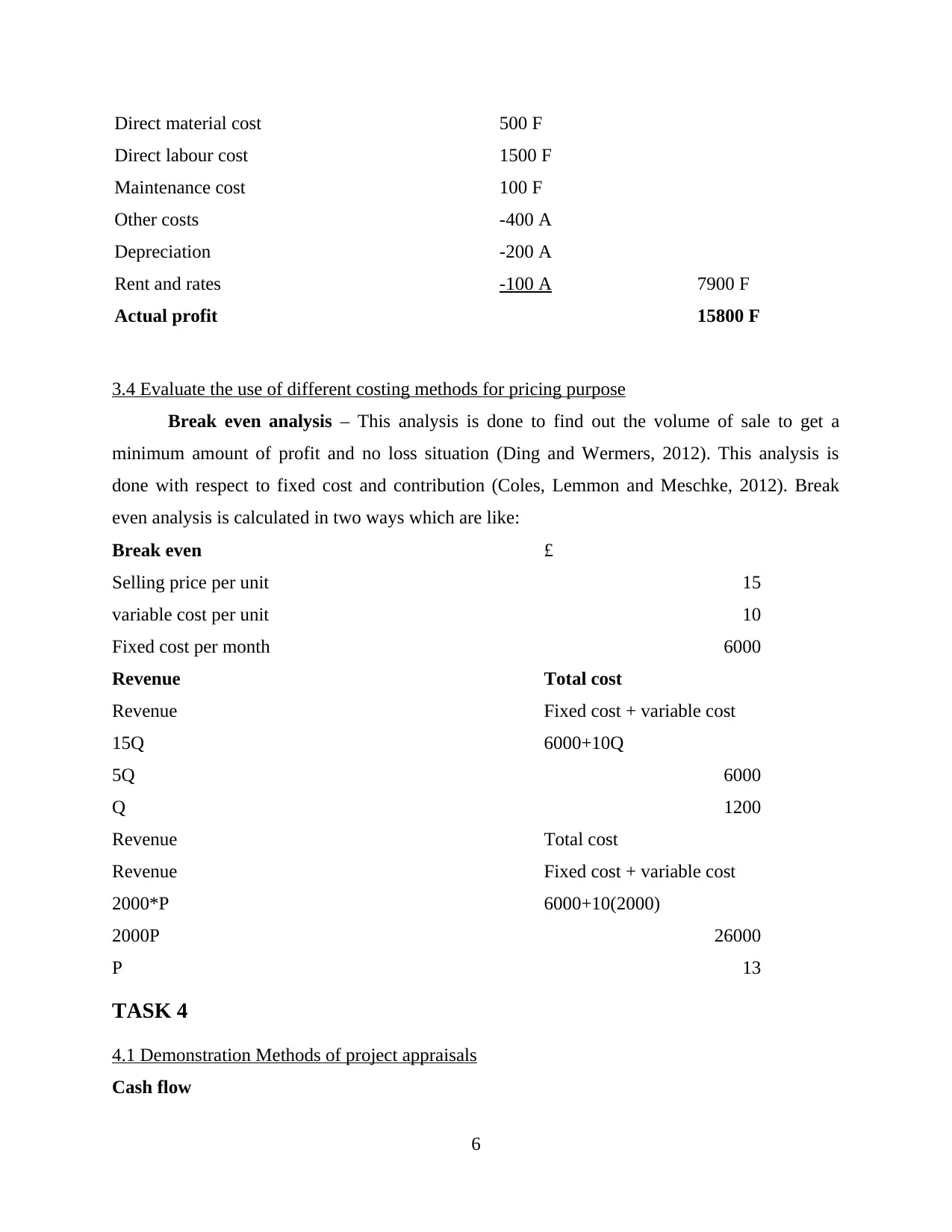
Direct material cost 500 F
Direct labour cost 1500 F
Maintenance cost 100 F
Other costs -400 A
Depreciation -200 A
Rent and rates -100 A 7900 F
Actual profit 15800 F
3.4 Evaluate the use of different costing methods for pricing purpose
Break even analysis – This analysis is done to find out the volume of sale to get a
minimum amount of profit and no loss situation (Ding and Wermers, 2012). This analysis is
done with respect to fixed cost and contribution (Coles, Lemmon and Meschke, 2012). Break
even analysis is calculated in two ways which are like:
Break even £
Selling price per unit 15
variable cost per unit 10
Fixed cost per month 6000
Revenue Total cost
Revenue Fixed cost + variable cost
15Q 6000+10Q
5Q 6000
Q 1200
Revenue Total cost
Revenue Fixed cost + variable cost
2000*P 6000+10(2000)
2000P 26000
P 13
TASK 4
4.1 Demonstration Methods of project appraisals
Cash flow
6
Direct labour cost 1500 F
Maintenance cost 100 F
Other costs -400 A
Depreciation -200 A
Rent and rates -100 A 7900 F
Actual profit 15800 F
3.4 Evaluate the use of different costing methods for pricing purpose
Break even analysis – This analysis is done to find out the volume of sale to get a
minimum amount of profit and no loss situation (Ding and Wermers, 2012). This analysis is
done with respect to fixed cost and contribution (Coles, Lemmon and Meschke, 2012). Break
even analysis is calculated in two ways which are like:
Break even £
Selling price per unit 15
variable cost per unit 10
Fixed cost per month 6000
Revenue Total cost
Revenue Fixed cost + variable cost
15Q 6000+10Q
5Q 6000
Q 1200
Revenue Total cost
Revenue Fixed cost + variable cost
2000*P 6000+10(2000)
2000P 26000
P 13
TASK 4
4.1 Demonstration Methods of project appraisals
Cash flow
6
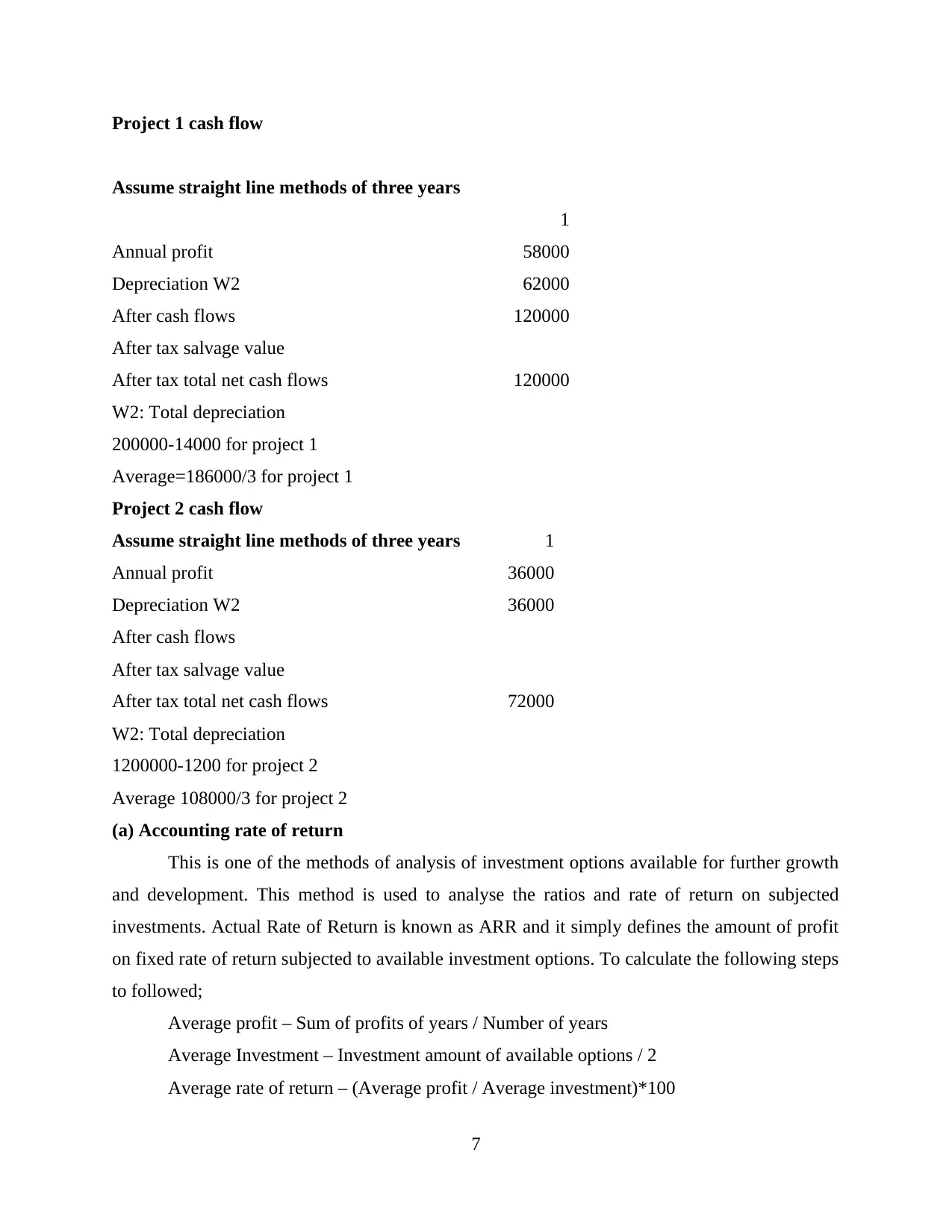
Project 1 cash flow
Assume straight line methods of three years
1
Annual profit 58000
Depreciation W2 62000
After cash flows 120000
After tax salvage value
After tax total net cash flows 120000
W2: Total depreciation
200000-14000 for project 1
Average=186000/3 for project 1
Project 2 cash flow
Assume straight line methods of three years 1
Annual profit 36000
Depreciation W2 36000
After cash flows
After tax salvage value
After tax total net cash flows 72000
W2: Total depreciation
1200000-1200 for project 2
Average 108000/3 for project 2
(a) Accounting rate of return
This is one of the methods of analysis of investment options available for further growth
and development. This method is used to analyse the ratios and rate of return on subjected
investments. Actual Rate of Return is known as ARR and it simply defines the amount of profit
on fixed rate of return subjected to available investment options. To calculate the following steps
to followed;
Average profit – Sum of profits of years / Number of years
Average Investment – Investment amount of available options / 2
Average rate of return – (Average profit / Average investment)*100
7
Assume straight line methods of three years
1
Annual profit 58000
Depreciation W2 62000
After cash flows 120000
After tax salvage value
After tax total net cash flows 120000
W2: Total depreciation
200000-14000 for project 1
Average=186000/3 for project 1
Project 2 cash flow
Assume straight line methods of three years 1
Annual profit 36000
Depreciation W2 36000
After cash flows
After tax salvage value
After tax total net cash flows 72000
W2: Total depreciation
1200000-1200 for project 2
Average 108000/3 for project 2
(a) Accounting rate of return
This is one of the methods of analysis of investment options available for further growth
and development. This method is used to analyse the ratios and rate of return on subjected
investments. Actual Rate of Return is known as ARR and it simply defines the amount of profit
on fixed rate of return subjected to available investment options. To calculate the following steps
to followed;
Average profit – Sum of profits of years / Number of years
Average Investment – Investment amount of available options / 2
Average rate of return – (Average profit / Average investment)*100
7
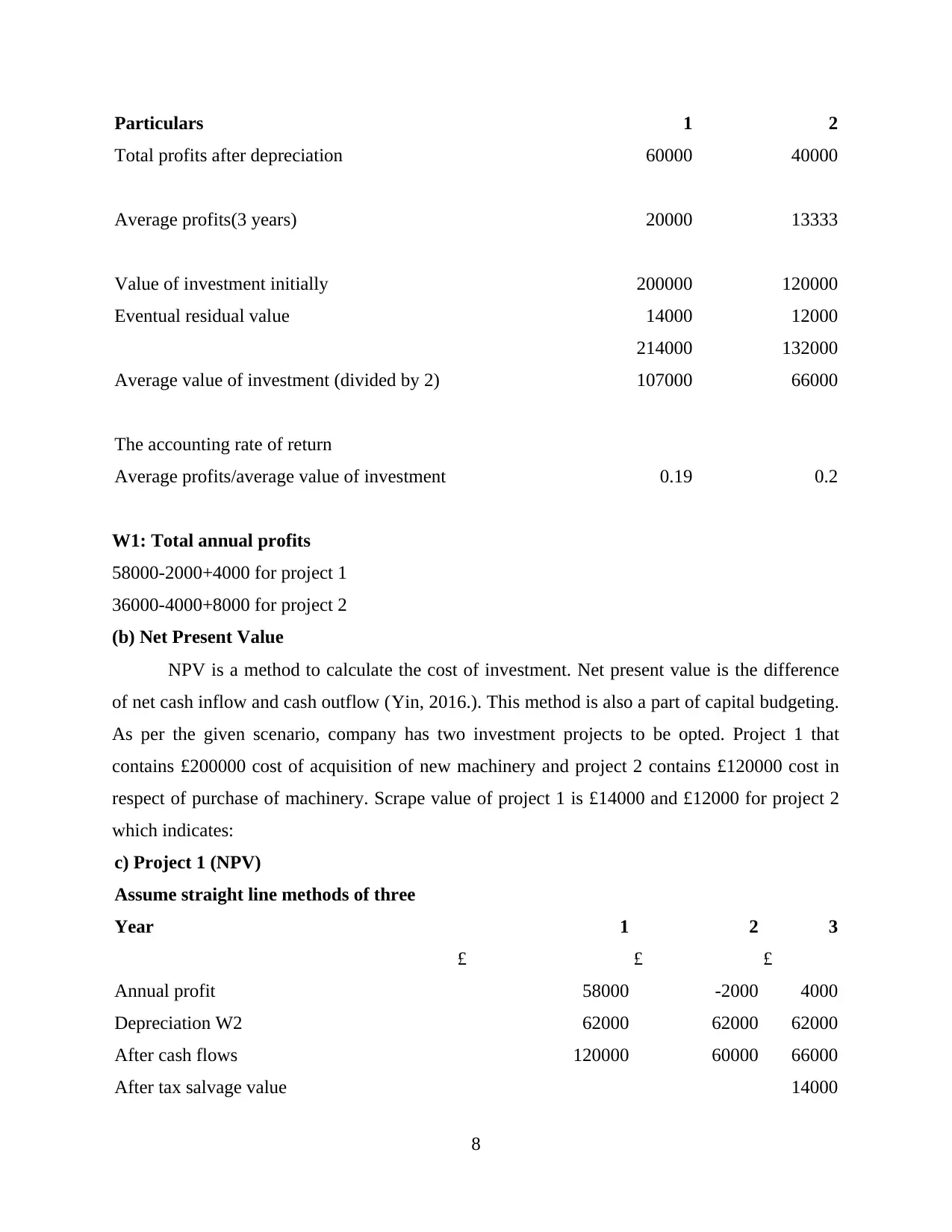
Particulars 1 2
Total profits after depreciation 60000 40000
Average profits(3 years) 20000 13333
Value of investment initially 200000 120000
Eventual residual value 14000 12000
214000 132000
Average value of investment (divided by 2) 107000 66000
The accounting rate of return
Average profits/average value of investment 0.19 0.2
W1: Total annual profits
58000-2000+4000 for project 1
36000-4000+8000 for project 2
(b) Net Present Value
NPV is a method to calculate the cost of investment. Net present value is the difference
of net cash inflow and cash outflow (Yin, 2016.). This method is also a part of capital budgeting.
As per the given scenario, company has two investment projects to be opted. Project 1 that
contains £200000 cost of acquisition of new machinery and project 2 contains £120000 cost in
respect of purchase of machinery. Scrape value of project 1 is £14000 and £12000 for project 2
which indicates:
c) Project 1 (NPV)
Assume straight line methods of three
Year 1 2 3
£ £ £
Annual profit 58000 -2000 4000
Depreciation W2 62000 62000 62000
After cash flows 120000 60000 66000
After tax salvage value 14000
8
Total profits after depreciation 60000 40000
Average profits(3 years) 20000 13333
Value of investment initially 200000 120000
Eventual residual value 14000 12000
214000 132000
Average value of investment (divided by 2) 107000 66000
The accounting rate of return
Average profits/average value of investment 0.19 0.2
W1: Total annual profits
58000-2000+4000 for project 1
36000-4000+8000 for project 2
(b) Net Present Value
NPV is a method to calculate the cost of investment. Net present value is the difference
of net cash inflow and cash outflow (Yin, 2016.). This method is also a part of capital budgeting.
As per the given scenario, company has two investment projects to be opted. Project 1 that
contains £200000 cost of acquisition of new machinery and project 2 contains £120000 cost in
respect of purchase of machinery. Scrape value of project 1 is £14000 and £12000 for project 2
which indicates:
c) Project 1 (NPV)
Assume straight line methods of three
Year 1 2 3
£ £ £
Annual profit 58000 -2000 4000
Depreciation W2 62000 62000 62000
After cash flows 120000 60000 66000
After tax salvage value 14000
8
Secure Best Marks with AI Grader
Need help grading? Try our AI Grader for instant feedback on your assignments.
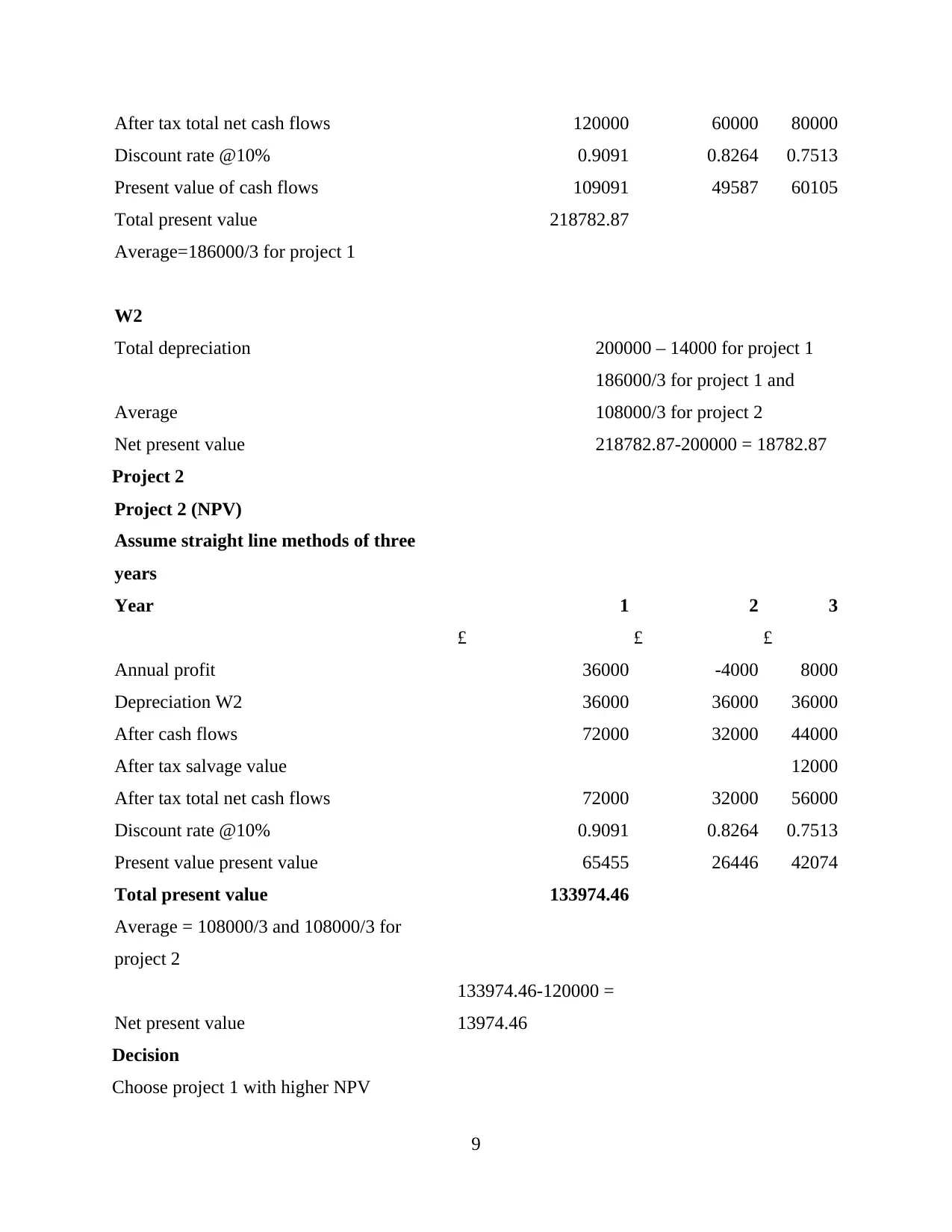
After tax total net cash flows 120000 60000 80000
Discount rate @10% 0.9091 0.8264 0.7513
Present value of cash flows 109091 49587 60105
Total present value 218782.87
Average=186000/3 for project 1
W2
Total depreciation 200000 – 14000 for project 1
Average
186000/3 for project 1 and
108000/3 for project 2
Net present value 218782.87-200000 = 18782.87
Project 2
Project 2 (NPV)
Assume straight line methods of three
years
Year 1 2 3
£ £ £
Annual profit 36000 -4000 8000
Depreciation W2 36000 36000 36000
After cash flows 72000 32000 44000
After tax salvage value 12000
After tax total net cash flows 72000 32000 56000
Discount rate @10% 0.9091 0.8264 0.7513
Present value present value 65455 26446 42074
Total present value 133974.46
Average = 108000/3 and 108000/3 for
project 2
Net present value
133974.46-120000 =
13974.46
Decision
Choose project 1 with higher NPV
9
Discount rate @10% 0.9091 0.8264 0.7513
Present value of cash flows 109091 49587 60105
Total present value 218782.87
Average=186000/3 for project 1
W2
Total depreciation 200000 – 14000 for project 1
Average
186000/3 for project 1 and
108000/3 for project 2
Net present value 218782.87-200000 = 18782.87
Project 2
Project 2 (NPV)
Assume straight line methods of three
years
Year 1 2 3
£ £ £
Annual profit 36000 -4000 8000
Depreciation W2 36000 36000 36000
After cash flows 72000 32000 44000
After tax salvage value 12000
After tax total net cash flows 72000 32000 56000
Discount rate @10% 0.9091 0.8264 0.7513
Present value present value 65455 26446 42074
Total present value 133974.46
Average = 108000/3 and 108000/3 for
project 2
Net present value
133974.46-120000 =
13974.46
Decision
Choose project 1 with higher NPV
9
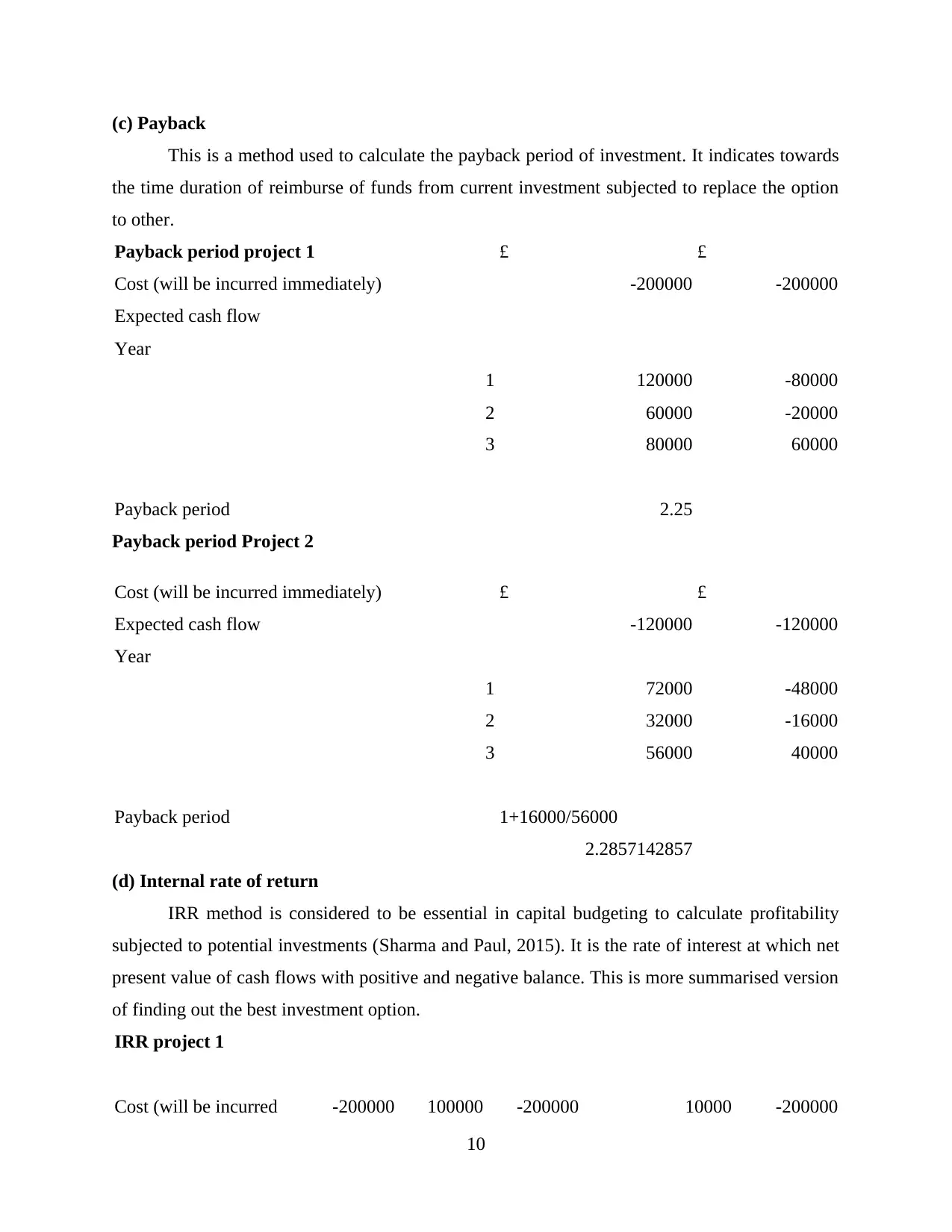
(c) Payback
This is a method used to calculate the payback period of investment. It indicates towards
the time duration of reimburse of funds from current investment subjected to replace the option
to other.
Payback period project 1 £ £
Cost (will be incurred immediately) -200000 -200000
Expected cash flow
Year
1 120000 -80000
2 60000 -20000
3 80000 60000
Payback period 2.25
Payback period Project 2
Cost (will be incurred immediately) £ £
Expected cash flow -120000 -120000
Year
1 72000 -48000
2 32000 -16000
3 56000 40000
Payback period 1+16000/56000
2.2857142857
(d) Internal rate of return
IRR method is considered to be essential in capital budgeting to calculate profitability
subjected to potential investments (Sharma and Paul, 2015). It is the rate of interest at which net
present value of cash flows with positive and negative balance. This is more summarised version
of finding out the best investment option.
IRR project 1
Cost (will be incurred -200000 100000 -200000 10000 -200000
10
This is a method used to calculate the payback period of investment. It indicates towards
the time duration of reimburse of funds from current investment subjected to replace the option
to other.
Payback period project 1 £ £
Cost (will be incurred immediately) -200000 -200000
Expected cash flow
Year
1 120000 -80000
2 60000 -20000
3 80000 60000
Payback period 2.25
Payback period Project 2
Cost (will be incurred immediately) £ £
Expected cash flow -120000 -120000
Year
1 72000 -48000
2 32000 -16000
3 56000 40000
Payback period 1+16000/56000
2.2857142857
(d) Internal rate of return
IRR method is considered to be essential in capital budgeting to calculate profitability
subjected to potential investments (Sharma and Paul, 2015). It is the rate of interest at which net
present value of cash flows with positive and negative balance. This is more summarised version
of finding out the best investment option.
IRR project 1
Cost (will be incurred -200000 100000 -200000 10000 -200000
10
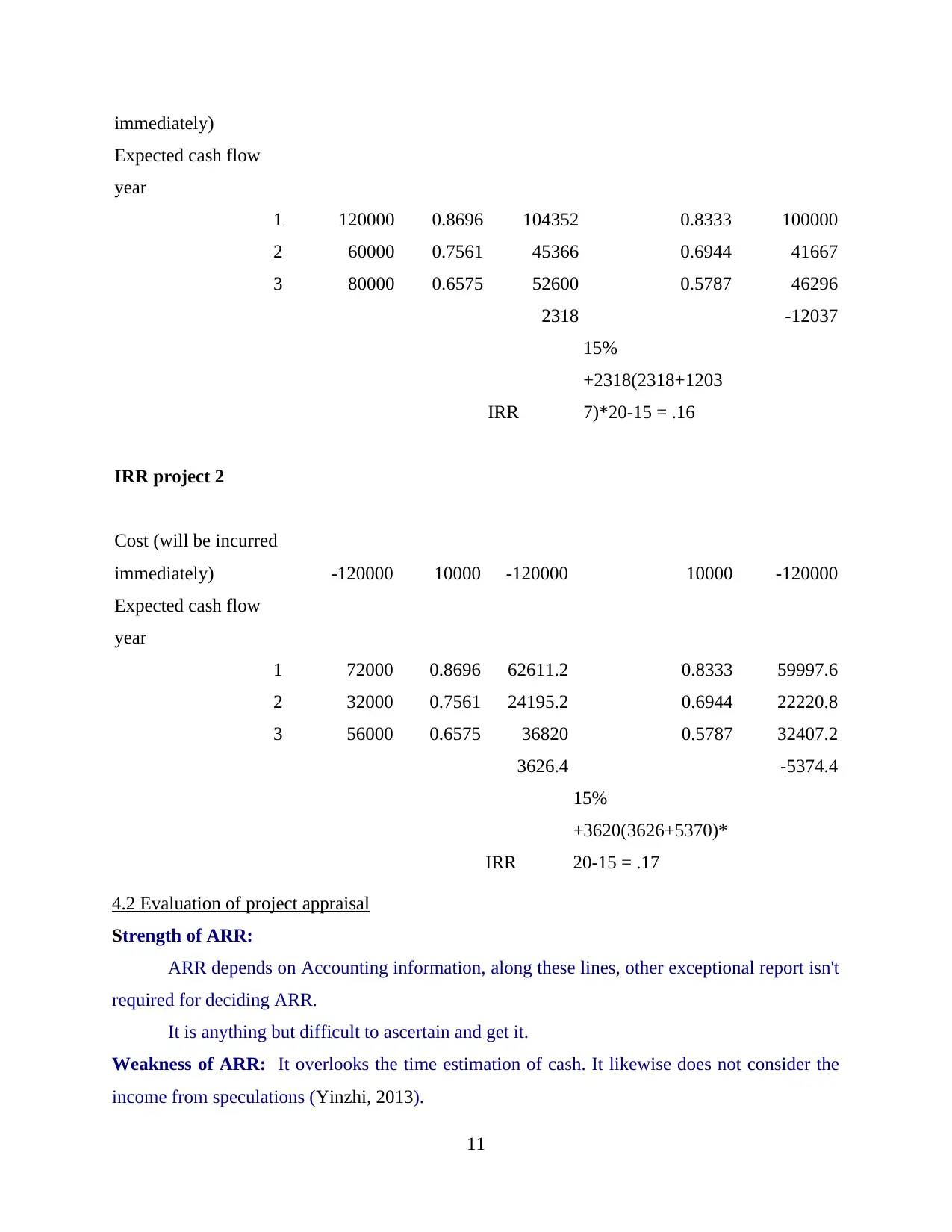
immediately)
Expected cash flow
year
1 120000 0.8696 104352 0.8333 100000
2 60000 0.7561 45366 0.6944 41667
3 80000 0.6575 52600 0.5787 46296
2318 -12037
IRR
15%
+2318(2318+1203
7)*20-15 = .16
IRR project 2
Cost (will be incurred
immediately) -120000 10000 -120000 10000 -120000
Expected cash flow
year
1 72000 0.8696 62611.2 0.8333 59997.6
2 32000 0.7561 24195.2 0.6944 22220.8
3 56000 0.6575 36820 0.5787 32407.2
3626.4 -5374.4
IRR
15%
+3620(3626+5370)*
20-15 = .17
4.2 Evaluation of project appraisal
Strength of ARR:
ARR depends on Accounting information, along these lines, other exceptional report isn't
required for deciding ARR.
It is anything but difficult to ascertain and get it.
Weakness of ARR: It overlooks the time estimation of cash. It likewise does not consider the
income from speculations (Yinzhi, 2013).
11
Expected cash flow
year
1 120000 0.8696 104352 0.8333 100000
2 60000 0.7561 45366 0.6944 41667
3 80000 0.6575 52600 0.5787 46296
2318 -12037
IRR
15%
+2318(2318+1203
7)*20-15 = .16
IRR project 2
Cost (will be incurred
immediately) -120000 10000 -120000 10000 -120000
Expected cash flow
year
1 72000 0.8696 62611.2 0.8333 59997.6
2 32000 0.7561 24195.2 0.6944 22220.8
3 56000 0.6575 36820 0.5787 32407.2
3626.4 -5374.4
IRR
15%
+3620(3626+5370)*
20-15 = .17
4.2 Evaluation of project appraisal
Strength of ARR:
ARR depends on Accounting information, along these lines, other exceptional report isn't
required for deciding ARR.
It is anything but difficult to ascertain and get it.
Weakness of ARR: It overlooks the time estimation of cash. It likewise does not consider the
income from speculations (Yinzhi, 2013).
11
Paraphrase This Document
Need a fresh take? Get an instant paraphrase of this document with our AI Paraphraser
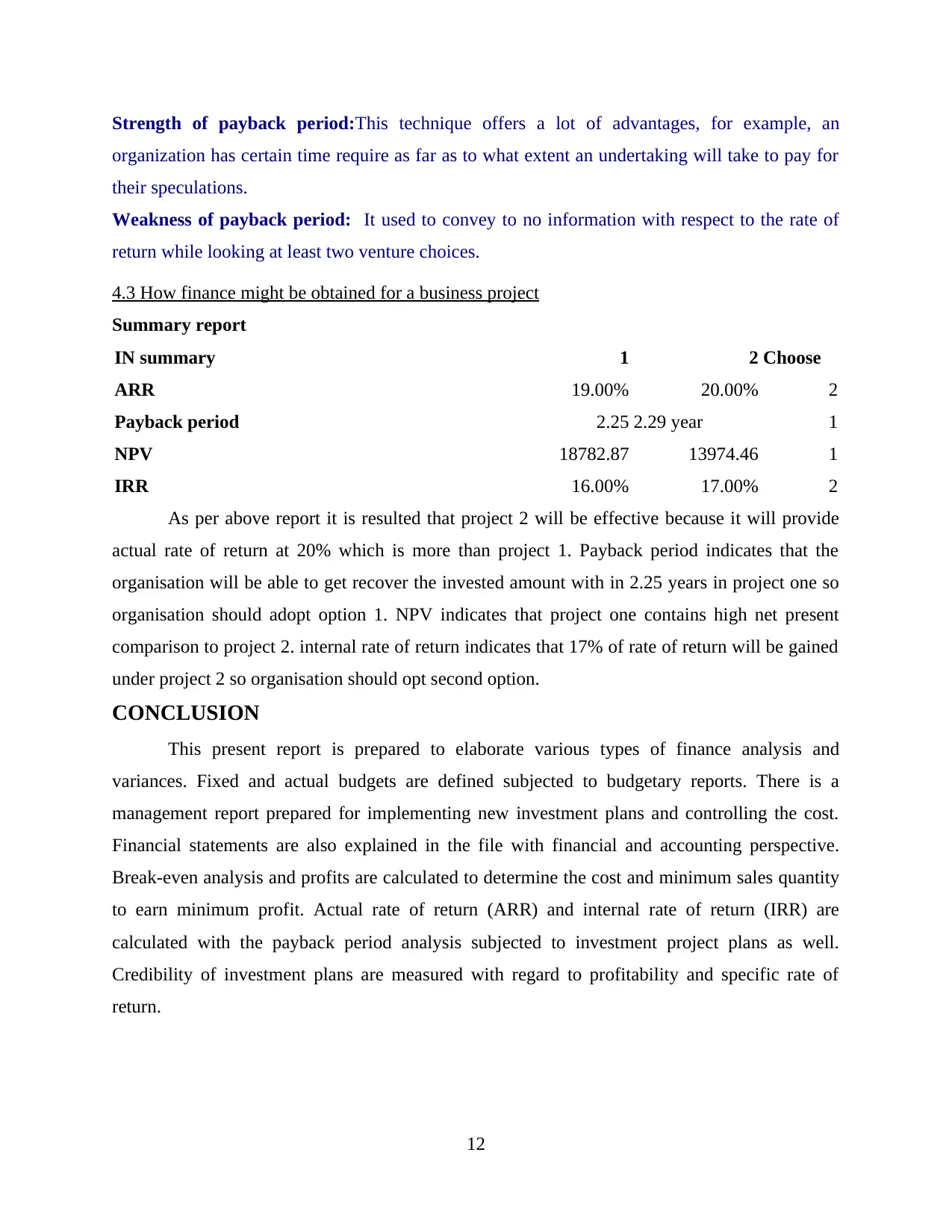
Strength of payback period:This technique offers a lot of advantages, for example, an
organization has certain time require as far as to what extent an undertaking will take to pay for
their speculations.
Weakness of payback period: It used to convey to no information with respect to the rate of
return while looking at least two venture choices.
4.3 How finance might be obtained for a business project
Summary report
IN summary 1 2 Choose
ARR 19.00% 20.00% 2
Payback period 2.25 2.29 year 1
NPV 18782.87 13974.46 1
IRR 16.00% 17.00% 2
As per above report it is resulted that project 2 will be effective because it will provide
actual rate of return at 20% which is more than project 1. Payback period indicates that the
organisation will be able to get recover the invested amount with in 2.25 years in project one so
organisation should adopt option 1. NPV indicates that project one contains high net present
comparison to project 2. internal rate of return indicates that 17% of rate of return will be gained
under project 2 so organisation should opt second option.
CONCLUSION
This present report is prepared to elaborate various types of finance analysis and
variances. Fixed and actual budgets are defined subjected to budgetary reports. There is a
management report prepared for implementing new investment plans and controlling the cost.
Financial statements are also explained in the file with financial and accounting perspective.
Break-even analysis and profits are calculated to determine the cost and minimum sales quantity
to earn minimum profit. Actual rate of return (ARR) and internal rate of return (IRR) are
calculated with the payback period analysis subjected to investment project plans as well.
Credibility of investment plans are measured with regard to profitability and specific rate of
return.
12
organization has certain time require as far as to what extent an undertaking will take to pay for
their speculations.
Weakness of payback period: It used to convey to no information with respect to the rate of
return while looking at least two venture choices.
4.3 How finance might be obtained for a business project
Summary report
IN summary 1 2 Choose
ARR 19.00% 20.00% 2
Payback period 2.25 2.29 year 1
NPV 18782.87 13974.46 1
IRR 16.00% 17.00% 2
As per above report it is resulted that project 2 will be effective because it will provide
actual rate of return at 20% which is more than project 1. Payback period indicates that the
organisation will be able to get recover the invested amount with in 2.25 years in project one so
organisation should adopt option 1. NPV indicates that project one contains high net present
comparison to project 2. internal rate of return indicates that 17% of rate of return will be gained
under project 2 so organisation should opt second option.
CONCLUSION
This present report is prepared to elaborate various types of finance analysis and
variances. Fixed and actual budgets are defined subjected to budgetary reports. There is a
management report prepared for implementing new investment plans and controlling the cost.
Financial statements are also explained in the file with financial and accounting perspective.
Break-even analysis and profits are calculated to determine the cost and minimum sales quantity
to earn minimum profit. Actual rate of return (ARR) and internal rate of return (IRR) are
calculated with the payback period analysis subjected to investment project plans as well.
Credibility of investment plans are measured with regard to profitability and specific rate of
return.
12
1 out of 14
Related Documents
Your All-in-One AI-Powered Toolkit for Academic Success.
+13062052269
info@desklib.com
Available 24*7 on WhatsApp / Email
![[object Object]](/_next/static/media/star-bottom.7253800d.svg)
Unlock your academic potential
© 2024 | Zucol Services PVT LTD | All rights reserved.





